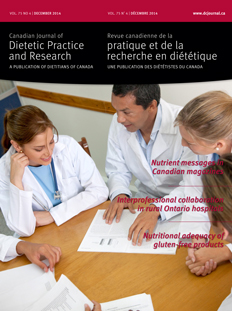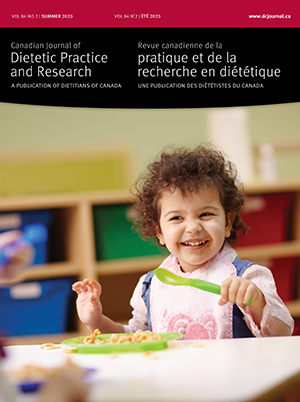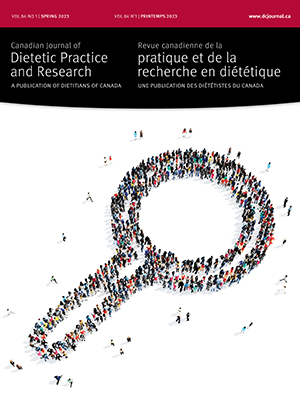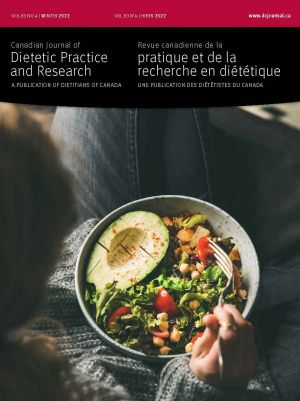Volume 75 • Number 4 • December 2014
Chair's Message
Editor's Message
Research
Purpose: The purpose of this study was to explore the concept of scope of practice for dietetics in Saskatchewan. Methods: Using interpretative description methodology, data were collected through 4 phases. This article reports on phases II and III. In phase II, 92 Saskatchewan Registered Dietitians (RDs) participated in an online survey on scope of practice. In phase III, 8 Saskatchewan RDs participated in a 3-week online focus group. Results: Results from phases II and III indicate that participants saw numerous opportunities in defining, understanding, and working with a scope of practice. Without a scope of practice, participants were interpreting their role from a combination of documents (e.g., ethics, research) and stakeholders (e.g., employers and colleagues). Current confusion amongst employers, other health professions, and RDs themselves regarding the role of dietitians was identified. Conclusion: Most participants believed a scope of practice would provide guidance to employers, other health professions, the public, regulatory bodies, and RDs themselves about the role of a dietitian. Dietetic regulators should continue to provide clear guidelines to their members and employers on safe dietetic practice. Dietitians need to be certain they are safely practicing within provincial policies and their own professional knowledge and skill at all times.
Purpose: Health care professionals are expected to work collaboratively across diverse settings. In rural hospitals, these professionals face different challenges from their urban colleagues; however, little is known about interprofessional practice in these settings. Methods: Eleven health care professionals from 2 rural interprofessional teams were interviewed about collaborative practice. The data were analyzed using a constant comparative method. Results: Common themes included communication, respect, leadership, benefits of interprofessional teams, and the assets and challenges of working in small or rural hospitals. Differences between the cases were apparent in how the members conceptualized their teams, models of which were then compared with an “Ideal Interprofessional Team”. Conclusions: These results suggest that many experienced health care professionals function well in interprofessional teams; yet, they did not likely receive much education about interprofessional practice in their training. Providing interprofessional education to new practitioners may help them to establish this approach early in their careers and build on it with additional experience. Finally, these findings can be applied to address concerns that have arisen from other reports by exploring innovative ways to attract health professionals to communities in rural, remote, and northern areas, as there is a constant need for dietitians and other health care professionals in these practice settings.
Purpose: Data from the Canadian Community Health Survey showed that calcium, vitamin D, iron, and folate are nutrients of concern for females 19–50 years of age. The study objectives were to assess the quantity, format, and accuracy of messages related to these nutrients in selected Canadian magazines and to examine their congruency with Canadian nutrition policies. Methods: Using content analysis methodology, messages were coded using a stratified sample of a constructed year for Canadian Living, Chatelaine, and Homemakers magazines (n = 33) from 2003–2008. Pilot research was conducted to assess inter-coder agreement and to develop the study coding sheet and codebook. Results: The messages identified (n = 595) averaged 18 messages per magazine issue. The most messages were found for calcium, followed by folate, iron, and vitamin D, and the messages were found primarily in articles (46%) and advertisements (37%). Overall, most messages were coded as accurate (82%) and congruent with Canadian nutrition policies (90%). Conclusions: This research demonstrated that the majority of messages in 3 Canadian magazines between 2003 and 2008 were accurate and reflected Canadian nutrition policies. Because Canadian women continue to receive much nutrition information via print media, this research provides important insights for dietitians into media messaging.
Perspectives in Practice
Purpose: There is concern about the nutritional quality of processed gluten-free (GF) products. The aim was to investigate the nutrient composition and cost of processed GF products compared with similar regular products. Methods: Product size, price, caloric value, and macro- and micronutrient composition were compared between foods labeled “Gluten-free” and comparable regular products in 5 grocery stores in 3 Canadian cities. Data were calculated per 100 g of product. Results: A total of 131 products were studied (71 GF, 60 regular). Overall, calories were comparable between GF and regular foods. However, fat content of GF breads was higher (mean 7.7 vs. 3.6 g, P = 0.003), whereas protein was lower (mean 5.0 vs. 8.0 g, P = 0.001). Mean carbohydrate content of GF pasta was higher (78 vs. 74 g, P = 0.001), whereas protein (7.5 vs. 13.3 g, P < 0.001), fibre (3.3 vs. 5.8 g, P = 0.048), iron (9% vs. 25%DV, P < 0.001), and folate content (5% vs. 95%DV, P < 0.001) were lower. Mean price of GF products was $1.99 versus $1.23 for regular products (P < 0.001). Conclusions: Some commonly consumed packaged GF foods are higher in fat and carbohydrates and lower in protein, iron, and folate compared with regular products. GF products are more expensive. Dietitians should counsel patients on the GF diet regarding its nutritional and financial impact.
The Good Food Box (GFB) is a program that offers fresh produce to community members. The implementation of a GFB pilot project targeting the elderly in Côte Saint-Luc (CSL) is described. Feasibility is evaluated in terms of partnerships necessary to realize the project and suitability of the GFB among seniors. Outcomes, lessons learned, and future directions are also discussed. GFBs were delivered biweekly for 10 weeks to 14 participants over the age of 65 years. Baseline and final surveys were administered to assess user satisfaction and effects of the project. Overall, participants were satisfied, finding the location convenient and the produce to be of excellent quality. Respondents also indicated an increased quantity of fresh fruits and vegetables in their home and an enhanced connection with the community. Many participants commented on excessive quantity and difficulty preparing certain products, demonstrating that the GFB may not be practical for all seniors. Smaller quantities and volunteer assistance could improve the program. Following the successful pilot project, the GFB was expanded to all members of the CSL community. Using the GFB as a major source of fresh produce will positively impact the health and quality of life for those who reside within the community.
A Nutrition Screening Form (NSF) was designed to identify lifestyle risk factors that negatively impact fertility and to provide a descriptive profile of 300 female infertility patients in a private urban infertility clinic. The NSF was mailed to all new patients prior to the initial physician's visit and self-reported data were assessed using specific criteria to determine if a nutrition referral was warranted. This observational study revealed that 43% of the women had a body mass index (BMI) <20 or ≥25 kg/m2, known risks for infertility. Almost half reported a history of “dieting” and unrealistic weight goals potentially limiting energy and essential nutrients. A high number reported eating disorders, vegetarianism, low fat or low cholesterol diets, and dietary supplement use. Fourteen percent appeared not to supplement with folic acid, 13% rated exercise as “extremely” or “very active”, and 28% reported a “high” perceived level of stress. This preliminary research demonstrated that a NSF can be a useful tool to identify nutrition-related lifestyle factors that may negatively impact fertility and identified weight, BMI, diet, exercise, and stress as modifiable risk factors deserving future research. NSF information can help increase awareness among health professionals and patients about the important link between nutrition, fertility, and successful reproductive outcomes.
Report
Reflections on Perceived Preparedness of Dietetic Internship Graduates Following Entry into Practice
Purpose: To report on the perceived level of preparedness of dietetic internship (DI) graduates for entrance into practice as dietitians. Methods: Graduates of an Ontario based, nonintegrated DI program from 2007–2011 who were at least 1 year postgraduation were surveyed to determine their level of perceived preparedness for practice using an electronic, content validated, self-administered questionnaire. Results: Of 38 eligible graduates, 23 (61%) responded. Seventy-five percent of respondents were working as clinical dietitians, and 30% were working as community dietitians. Eighty-five percent of graduates reported feeling well or very well prepared for practice. Clinical and professional practice tasks were scored highest in terms of preparedness (ratings above 4.5/5) and research-related tasks such as using the research literature (4.1/5), making evidence-based decisions (4.2/5), and engaging in practice-based research (4.1/5) scored lower. Training gaps identified by 32% of respondents included community nutrition and management skill training. Conclusions: Overall, results indicate that this DI program provides a positive training experience that prepares its graduates for entrance into practice as dietitians. Qualitative comments identifying gaps and improvements have guided changes to the curriculum including strengthening community-based placements. Post-graduate surveys represent an important tool in assuring that training programs evolve to meet the needs of students entering the workforce.
Purpose: To describe and provide recommendations for the implementation of an evaluation for an already existing, in-store Nutrition Label Education Program (NLEP). Methods: We describe the development and implementation of an evaluation consisting of a pre- and postsurvey and one month follow-up. The evaluation was designed to assess satisfaction with the NLEP as well as changes in participant nutrition label knowledge, confidence in using nutrition labels, and actual changes in nutrition label use. Results: Nineteen participants took part in the pilot evaluation. The evaluation was successful in demonstrating high levels of satisfaction with the NLEP as well as positive changes in participant confidence and some increased knowledge in using nutrition labels. However, only 3 people participated in the follow-up, limiting the ability to assess behaviour change. Conclusions: Ideally, NLEPs should include ongoing evaluation that extends beyond just assessing participant satisfaction. Recommendations are provided for conducting such evaluations, including the importance of incorporating the evaluation into the program itself, using existing questionnaires when possible, and employing pre- and postsurveys as well as follow-up interviews to assess change.
Purpose: Coaches’ sports nutrition knowledge and subsequent nutrition recommendations can have an impact on athletes’ health and performance. The purpose of this study was to determine sports nutrition knowledge and nutrition recommendation practices of varsity coaches at one Canadian university and to determine if the coaches’ nutrition knowledge influenced nutrition recommendations to athletes. The coaches’ accessibility to sports dietitians was also examined. Methods: Coaches (n = 5) completed a modified psychometrically validated nutrition knowledge questionnaire and a semi-structured interview. Mean scores were calculated for questionnaire answers based on the correct answer and the coach's degree of certainty in their answer. Interviews were analyzed using thematic analysis. Results: Results showed a low nutrition knowledge, yet all coaches made nutrition recommendations to their athletes for fluid needs, dietary supplementation, and weight management; areas that may be potentially detrimental to the health of athletes. In addition, they made recommendations with regard to fluid needs, training diet, precompetition diet, recovery diet (i.e., post training or competition), dietary supplementation, and weight management; areas that could have potentially negative performance consequences to the athlete. Conclusions: It was determined that coaches had low nutrition knowledge scores and still made nutrition recommendations to athletes. The importance of sports dietitian involvement in varsity athletics is emphasized.
Purpose: To explore the role of breakfast cereal consumption on the relationships among BMI, percent fat mass (%FM), and body esteem in young adults. Methods: Weight, height, and %FM (by air displacement plethysmography) were measured in 29 males (aged 25.1 ± 4.0 years) and 28 females (aged 24.6 ± 4.0 years). Body esteem was measured using the Body Esteem Scale for Adolescents and Adults (BESAA). Three-day food records classified participants as breakfast cereal consumers (n = 27, any amount of ready-to-eat or cooked cereal consumed at breakfast) versus nonconsumers (n = 30, no cereal consumed at breakfast). Results: The %FM was significantly (P ≤ 0.05) inversely correlated with weight esteem (r = −0.769), appearance esteem (r = −0.723), and external attribution (r = −0.620) in female noncereal consumers. BMI was similarly correlated with BESAA scores. These relationships were not significant in female cereal consumers (all r < 0.426), despite no difference in confounding variables between female cereal consumers and nonconsumers. Neither BMI nor %FM were correlated with measures of body esteem (all r < 0.466, NS) in either male cereal consumers or nonconsumers. Conclusions: Breakfast cereal consumption may moderate the relationship among BMI, %FM, and body esteem in young adult women and may be useful for improving body esteem without focusing on weight loss.
Purpose: Consumption of pulses is recommended to improve diet quality and decrease the risk of chronic disease. However, their constituent α-galactosides, including raffinose, are commonly thought to contribute to unpleasant gastrointestinal symptoms. Methods: Using a random crossover design, healthy adults (n = 12) received control foods, control foods with 5 g raffinose, and foods with 200 g of canned chickpea (11 g fibre per day), each for three weeks following a 3-day diet rotation. Gastrointestinal symptoms (rating 0 = none to 3 = severe), compliance, and stool frequency were recorded daily. Results: No change in daily stool frequency (mean ± SD) was found with chickpea (1.7 ± 0.3) or raffinose (1.7 ± 0.4) compared with control (1.5 ± 0.3). Reported flatulence (mean ± SD) was rated higher with chickpea (1.0 ± 0.2, P < 0.001) and raffinose (0.7 ± 0.2, P < 0.001) compared with control (0.4 ± 0.1). Although bloating was infrequent, ratings were higher with chickpea (0.2 ± 0.1, P < 0.001) and raffinose (0.3 ± 0.1, P < 0.001) compared with control (0.0). No differences were found for diarrhea or abdominal pain. Conclusions: As gastrointestinal symptoms were mild for most participants, canned chickpea may be a feasible way of increasing pulse intake and improving overall diet quality.










